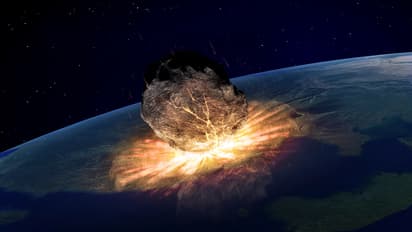NASA alert! Two giant aeroplane-sized asteroids to pass Earth on September 24. Here's all you need to know

Synopsis
According to NASA's Jet Propulsion Laboratory, two giant asteroids are coming towards the Earth at breakneck speed and will make their closest approach on September 24, 2024.
In a cosmic dance of the heavens, two large asteroids, each the size of a commercial airliner, are set to pass by Earth on September 24, 2024, according to NASA’s Jet Propulsion Laboratory (JPL). Although these space rocks will come relatively close, scientists assure there is no need for alarm. Instead, this event presents an extraordinary opportunity for astronomers to observe these celestial bodies from a safe distance.
The first of these asteroids, 2020 GE, is the smaller of the duo, measuring around 26 feet in diameter—roughly the size of a city bus. This asteroid will pass just beyond the Moon’s orbit, at about 410,000 miles from Earth. “Although 2020 GE is passing closer than we typically see, it poses no threat to our planet,” NASA officials stated, confirming that this close encounter will be harmless. For those with specialized telescopes, this flyby offers a rare chance to witness such an event.
The second, more recently discovered asteroid, 2024 RO11, is a colossal 120 feet in diameter, making it comparable in size to a large airplane. It will pass by Earth at a distance of 4.85 million miles, a distance too far for it to be visible to the naked eye but within reach of advanced observational tools. Though larger, it too poses no danger to Earth.
As if this isn’t enough for space enthusiasts, another asteroid, 2024 RK7, will make its appearance on September 25. Slightly smaller at 100 feet across, this asteroid will also pass by safely, reinforcing NASA’s assurance that none of these objects pose a risk of collision with Earth.
Should we be worried?
Not at all. NASA’s Jet Propulsion Laboratory has continuously monitored these asteroids and confirmed that they will sail past Earth without any incident. "There's no risk of a collision," experts have reiterated. This is not an unprecedented occurrence, but rather a fascinating display of our dynamic solar system in action.
The fascinating world of asteroids
Asteroids are often referred to as the rocky relics of the solar system, remnants from the formation of our cosmic neighborhood some 4.6 billion years ago. Known as "minor planets," these objects range in size from small rocks to massive bodies stretching hundreds of miles across. The majority of asteroids orbit the Sun in a region known as the asteroid belt, located between Mars and Jupiter.
Despite their relatively small size compared to planets, asteroids are far from insignificant. If one were to collide with Earth, the impact could be catastrophic, which is why scientists keep a close eye on their trajectories. Moreover, these ancient space rocks offer valuable clues about the early solar system, making them prime targets for ongoing space missions.
For now, though, the September flybys promise nothing but a safe and exciting spectacle for astronomers and space enthusiasts alike.
Check the Breaking News Today and Latest News from across India and around the world. Stay updated with the latest World News and global developments from politics to economy and current affairs. Get in-depth coverage of China News, Europe News, Pakistan News, and South Asia News, along with top headlines from the UK and US. Follow expert analysis, international trends, and breaking updates from around the globe. Download the Asianet News Official App from the Android Play Store and iPhone App Store for accurate and timely news updates anytime, anywhere.